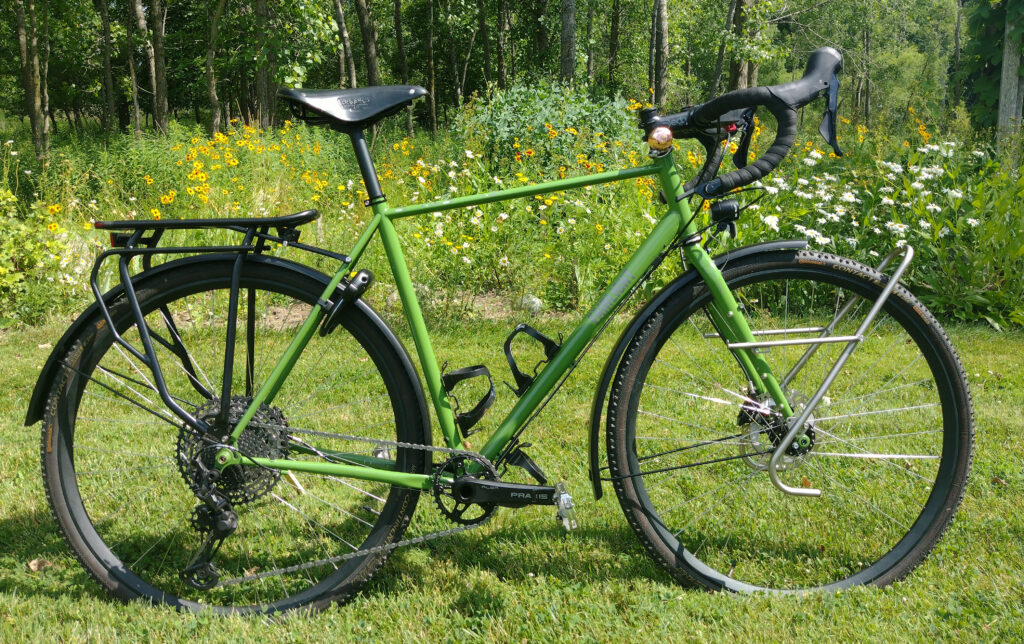
This is my custom Fairlight Faran 2.0 touring bike. Fairlight is a small UK manufacturer of road, gravel and touring/utility bikes, and I came across the Faran when I started looking into building a ‘modern’ touring bike. Specifically, I was looking for a drop-bar frame with thru-axle dropouts both front and rear, disc brake mounts, and a fork capable of mounting a front rack. When I started planning this build back in 2019 there were very few bikes which met this criteria – the options were basically the Fairlight Faran, the Pipedream A.L.I.C.E., and the Trek 920 (which has since been discontinued).
The Fairlight Faran was the most expensive option, but it had the most refined design compared to the other choices. For example, while similarly priced to the Faran 2.0, the Pipedream A.L.I.C.E. only comes in 4 frame sizes while the Fairlight comes in 10 sizes, making it much easier to get a near-custom fit. The Trek 920 was also only slightly less expensive than the Fairlight, but it was a mass produced aluminum frame compared to the custom-fabricated steel Fairlight Faran 2.0, and it also only came in 6 frame sizes. The final nail in the coffin for these alternatives was the fact that neither was actually available to order at the time due to Covid supply chain issues and the fact that unbeknownst to me the Trek 920 had been discontinued. So it seemed like the Fairlight Farn 2.0 was meant to be – I ordered my frame in May 2021 and it was shipped out in September 2021, arriving in the US a few days after it was shipped. It took me over 1 year to choose and source all of the components, and the actual build was completed in May 2022.
One of the biggest selling points of the Fairlight Faran 2.0 is the geometry. In their design notes, Fairlight explain that the Faran concept is a bicycle which is fast and agile when unloaded, but stable with a load on the bike. In particular, this comes down to the design of the fork, which has a relatively low ‘trail’ – a measure of how far behind the steering axis the tire contacts the ground. This really works well with my idea to build a ‘modern’ alternative to the classic touring bike. Traditional touring bikes tend to have short top tubes and big stack sizes, which gives them a more upright riding position, but I wanted something which more closely matches the geometry of my Pinnacle Arkose gravel bike – not quite as upright as a typical touring bike, but not as low and stretched out as a typical road bike either.
This requirement is made difficult by the fact that I have relatively long legs and arms for my height – I am 178cm tall but have an 86cm ‘cycling inseam’ – which means that many bikes feel too stretched out to me because they have too much reach and not enough stack to fit my body proportions. Fairlight solves this for me by offering ‘proportional sizing’, which means that each frame size is available in both ‘regular’ and ‘tall’ versions, which have a slightly higher stack size. They are also very vested in making sure you end up with the right frame size for you, not only offering a calculator where you can input your own body proportions to get a recommended frame size, but also offering a service to either translate bike fit data or the measurements of one of your existing bikes into a recommended frame size. I used their calculator and also measured my Pinnacle Arkose to be extra sure I bought the right frame size, and ended up with a Fairlight Faran 2.0 in size 56T, which is working out very well for me.
The Fairlight Faran frameset is made of Reynolds 631 steel which is a type of chromoly steel, meaning that it is alloyed with chromium and molybdenum for increased strength and stiffness. Reynolds 631 is not heat-treated which means that it is very tough and durable, but also relatively cost effective. The really great thing about Fairlight is that they invest a significant amount of effort into refining their frame designs. Each piece of tubing is custom drawn and butted which optimizes its shape and thickness to match the loads imposed on it, for example the downtube is ovalized horizontally around the bottom bracket to improve lateral stiffness, but ovalized vertically around the head tube to resist the braking forces imposed by the fork. The Fairlight Faran frameset costs approximately $1,000, which is on the more expensive side, but Fairlight’s design efforts and attention to detail mean that it should have a high strength to weight ratio as well as excellent handling and compliance.
Specifications
My Fairlight Faran 2.0 was completely custom built by me. Here is the full spec of the bike:
Frame: Fairlight Faran 2.0 (Size 56T), Custom Drawn & Butted Reynolds 631 Tubing, 12x142mm Thru Axle
Fork: Fairlight Steel, straight 1 1/8″ Steerer
Rear Derailleur: Shimano SLX RD-M7100-SGS 12-Speed
Shifter: Microshift BS-M12-R
Bottom Bracket: Praxis Works M30 BSA 68mm
Crankset: Praxis Works Alba 170mm
Chainring: Wolf Tooth Camo 32T Elliptical on Wolf Tooth Camo M2 Spider (6mm Offset)
Cassette: Shimano SLX M7100 10-51T
Brake Levers: Shimano GRX RX400
Brake Calipers: Hope RX4+
Brake Discs: Shimano XT MT800 160mm
Handlebars: Deda Zero 1 440mm
Stem: Deda Zero 90mm
Headset: FSA Orbit X Sealed Cartridge Bearing
Front Hub: Shimano DH-UR705-3D 36h 12x100mm Dynamo Hub
Rear Hub: Shimano FH-MT510 36h 12x142mm
Rims: DT Swiss HX491
Spokes: DT Swiss 14/15/14g Double Butted Silver
Rear Tire: Continental Contact Travel 42-622
Front Tire: Continental Contact Travel 42-622
Saddle: Brooks B17 Black Leather
Seatpost: Generic Alloy
Front Rack: Tubus Tara Stainless
Rear Rack: Racktime GleamIt 2.0 w/ Integrated Tailight
Front Light: Busch + Müller IQ-XS T Senso Plus
Other: Zefal Bottle Cages, Abus 5650L Ring Lock, SKS Edge AL 56 Mudguards, Crane Mini Suzu Stem Bell (Copper), Merida Wahoo Top Cap Mount
Drivetrain
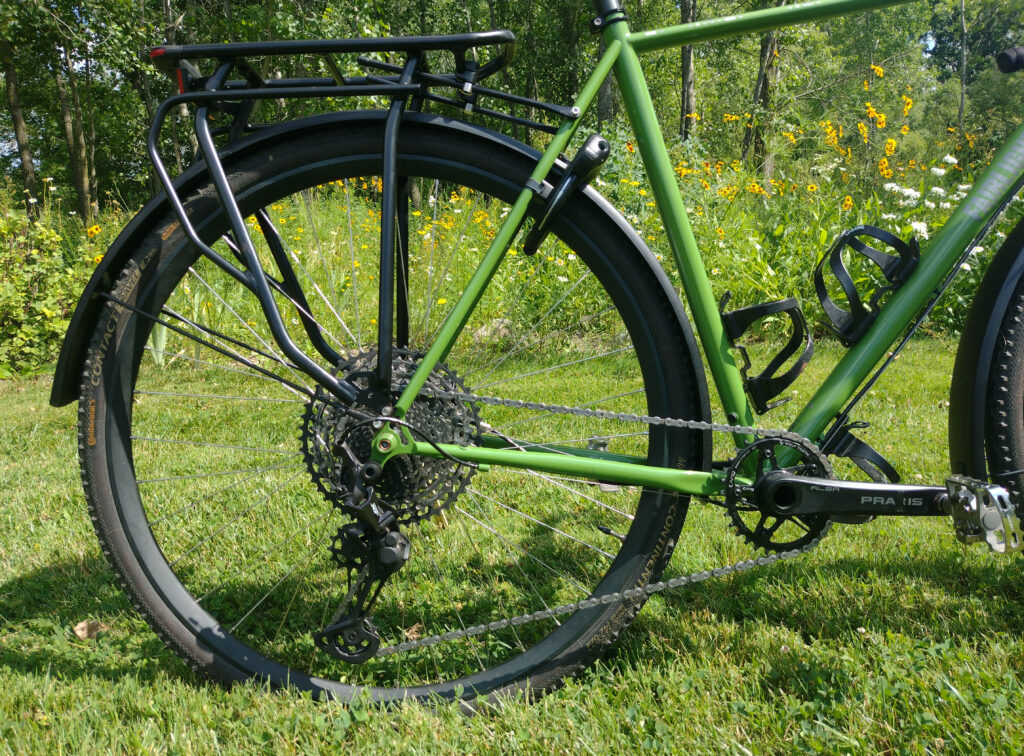
I spent a significant amount of time thinking about the design of this bike, and every component was chosen very carefully. The most unique thing about the bike is the drivetrain, which is a 1×12 Shimano-based mullet setup. The crankset is a Praxis Alba which is a road bike crankset with a narrow Q-factor of 147mm, and I opted for a crank length of 170mm for more comfort and pedaling efficiency. I swapped the stock chainrings for a Wolf Tooth Camo spider paired with a 32T Wolf Tooth mountain bike chainring which features Wolf Tooth’s Shimano 12-speed specific Drop Stop ST tooth profile for better chain retention, and I also decided to try an oval chainring which theoretically results in a smoother pedal stroke.
The cassette is a Shimano SLX M7100 10-51T which is paired with a Shimano SLX RD-M7100-SGS derailleur. The 10-51T cassette paired with a 32-tooth chainring and 42-622 tires results in a range of 17.51 to 88.94 gear-inches. It is very difficult to achieve a reasonable range of gears for cycle touring with a 1x drivetrain, and in my case I prioritized achieving an ultra low ‘granny gear’ to be able to pull heavy loads up inclines at the expense of top-end speed. I also have relatively large gaps between the gears with this setup and that is noticeable, but on the plus side there is a very high cool factor with this drivetrain which is hard to beat and almost certainly worth the trade-offs. Or at least that’s what I told myself.
It is not possible to directly shift a 12-speed mountain bike derailleur using road bike shifters, but rather than using a hack or adapter I opted to install a Microshift BS-M12-R bar-end shifter. The shifter can be set up as an indexed shifter but I am running it in friction mode which should be very reliable and works surprisingly well with the narrow 12-speed chain. The one downside to this setup is that there is no barrel adjuster built into the SLX derailleur so in theory I should be using an inline adjuster, but I found that precise adjustment of cable was not necessary because the shifter has enough range to reach the full cassette even if the cable is not adjusted perfectly.
The ideal chainline for a Shimano 12-speed cassette is 52mm, but the chainline of the Praxis Alba crankset is 45.5mm. Road cranks use a standard offset of 6mm, which means that the chainrings are dished 6mm towards the frame to achieve the 45.5mm chainline, so I selected the Wolf Tooth Camo M2 spider with a 0mm offset to push the chainline an extra 6mm away from the frame. This resulted in an overall chainline of 51.5mm, which is the closest I could get to the ideal of 52mm. Overall, the Praxis Alba crankset with the Wolf Tooth Camo spider was one of the few ways I found to be able to run a small mountain bike chainring on a road bike, and perhaps the only way to do it (as of early 2022) and end up with the correct chainline as well as a narrow road-style Q-factor.
The 1x system is great for simplicity and there is no front derailleur rub to worry about, but the tradeoff is that the gaps between the gears are relatively large, and the lack of a second chainring means that all of the wear is concentrated on the single front ring. This means that the chainring durability might not be as good as on a 2x or 3x system, especially since the chainring is made of aluminum rather than steel. I am also not sure how well the 12-speed chain will hold up for touring because 12-speed chains have to be very narrow to be able to fit 12 gears on the cassette, but early research seems to point towards 12-speed chains actually being more durable than their 11-speed counterparts.
Brakes
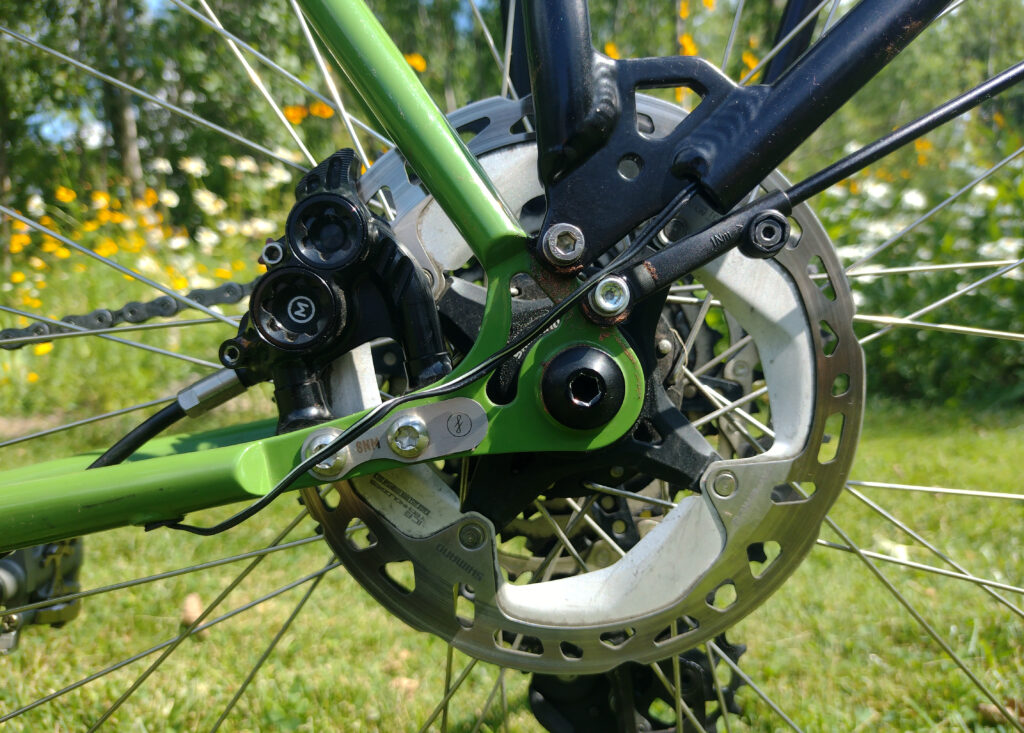
One of my pet peeves is weak brakes, so I opted for Hope RX4+ calipers front and rear, which are one of the few 4-piston flat mount brake calipers on the market for greater stopping power. The maximum brake rotor size on this frameset is 160mm due to the flat-mount caliper mounting standard, and I wanted to get the best braking performance possible with the small rotor size, so I went with Shimano XT MT-800 rotors front and rear which feature so-called ‘Ice Technologies Freeza’ technology. This is a fancy way of saying that the rotors are made out of a sandwich of steel and aluminum which helps with heat dissipation and therefore theoretically reduces brake fade and prevents warping. The actual discs also mounted to an aluminum carrier which also helps draw heat away from the braking surfaces. The brake calipers came with both sintered and organic pads and I was going to go with the sintered version which are much more durable so should have more braking power, but Hope organic pads have better reviews than their sintered pads and sintered pads also tend to squeal, so I ended up using organic pads for now. Braking performance is adequate although they don’t quite have the stop on a dime and throw you over the front power I was really looking for.
Hope RX4+ calipers are available in Sram and Shimano versions, but I opted for the Shimano version which uses mineral oil rather than Dot 4 brake fluid. I connected them to a pair of Shimano GRX RX400 levers, which have an integrated shift mechanism, but since I am using a bar-end shifter I won’t be using the GRX levers to shift so I bought the least expensive 10-speed levers. I was originally going to go with TRP Hylex brake levers which are specifically designed for singlespeed bikes, but TRP uses 5.5mm brake hose whereas Shimano uses 5mm brake hose so I wasn’t sure if the TRP levers could be safely connected to the Hope calipers. I also like the feeling of GRX brake hoods very much, they are slightly taller than most other hoods which improves confidence in rough terrain, and the levers are also very ergonomic. The cherry on top is that the GRX levers even came out a little cheaper than the TRP Hylex option.
Wheels and Tires
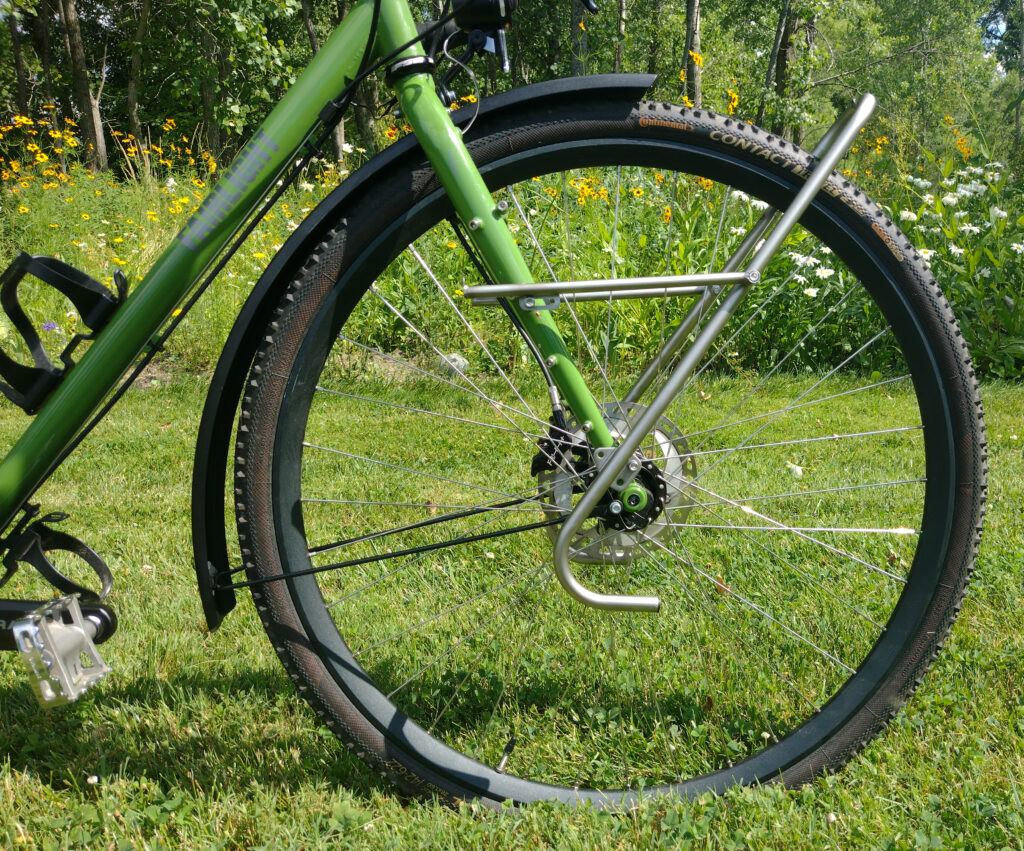
I custom selected all of the components of the wheelset including the rims, hubs, spokes, and tires. The rims are DT Swiss HX491 ‘hybrid’ rims in 700C which have a 25mm internal rim width. These are welded aluminum rims rated for a system weight of 150kg (330lb) as well as ASTM classification 4 riding conditions, which means that they are capable of being used on rough downhill trails at up to 40kph (25mph) and on drops of up to 122cm (48″), all of which is far beyond what the bike will likely actually experience in practice.
The rims have 36 spoke holes and are paired with a Shimano FH-MT510 mountain bike hub at the rear and a Shimano DH-UR705-3D dynamo hub at the front. The rear hub takes a 142x12mm thru-axle and features a Microspline freehub which is necessary to install Shimano 12-speed mountain bike cassettes, and the front hub takes a 100x12mm thru-axle. The advantages of Shimano hubs are that they are cost-effective but have a reputation for robustness, they use the center-lock brake rotor mounting standard which I prefer, and they also use cup and cone bearings which are easier to service and regrease in the field. I did recently find out that Shimano dynohubs are actually not meant to be serviced, but according to YouTube it is possible to disassemble them and regrease the bearings – another bridge I’ll cross when I come to it.
The spokes are DT Swiss 14/15/14g (2.0/1.8/2.0mm) double-butted spokes in silver, which are less expensive than black spokes and should also wear better. There are a lot of silver components on the bike so I think that the combination of the black rims and hubs with silver spokes fits the bike’s aesthetic well as well. The spoke nipples are standard DT Swiss brass nipples with a length of 12mm.
The wheels were laced using the Shimano wheel lacing pattern, which calls for trailing spokes to the inside of the hub flange on both sides of the front wheel as well as well as on the non-drive side of the rear wheel. This puts the outer spokes into tension under breaking, which prevents them from bending outward as they slacken. It also protects the J-bend because the outside spoke presses against the hub flange during braking, which causes the spoke to bend about this point where the spoke is straight and strong rather than at the J-bend where it is weaker. The drive side of the rear wheel is laced the opposite way, with the trailing spokes to the outside of the hub flange, because the driving torque is higher than the braking torque on that side of the wheel so the highest forces will be opposite to the rest of the wheel in this location. The wheels were built using no special tools – the frame of the bike was used as a truing stand and two blocks of wood and some washers were used as a dishing gage. Spoke tension uniformity was checked by sound and feel.
The tires are Continental Contact Travel 42-622. I felt that this tire was a good compromise between weight and durability, and I also like that this tire has a smooth central tread which I have found minimizes rolling resistance while allowing the tread at the side of the tire to dig in in the corners or on soft terrain. I originally wanted a folding tire with a kevlar bead, but most tires in this class have wire beads which adds a little weight but makes them more affordable, and the actual performance of the tire should be the same. The tire width is 42mm which is within the allowable range for the Fairlight Faran, and the inner tubes are Continental Cross which are a little thicker than normal tubes but not as thick as the Continental Tour heavyweight inner tube.
Contact Points
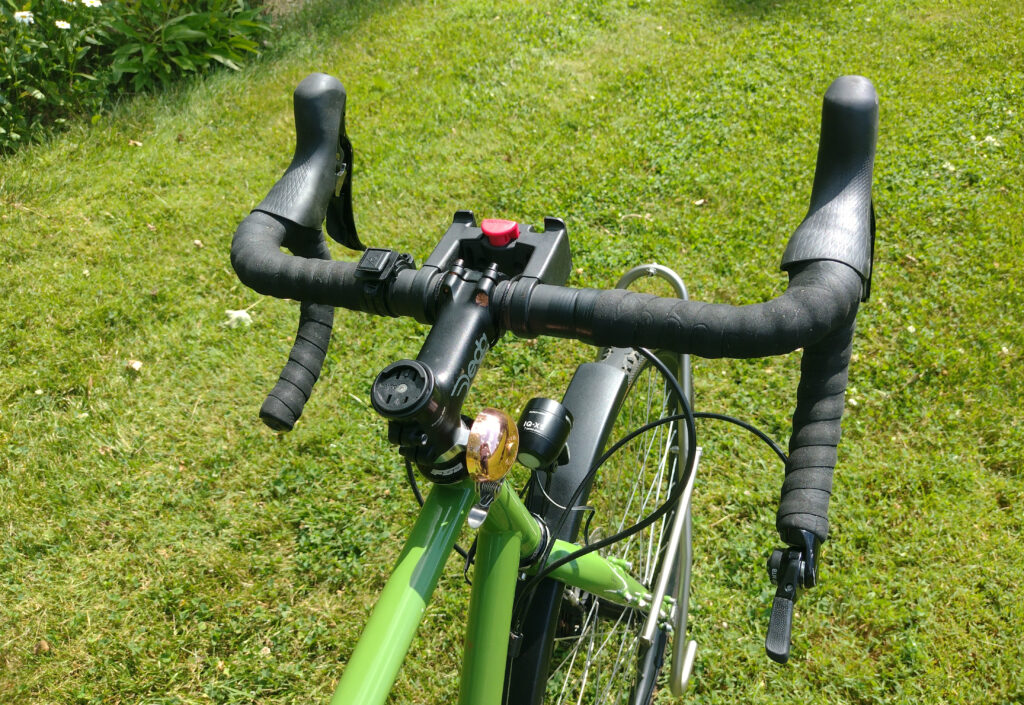
The pedals I chose are Shimano M324 combination pedals which are compatible with Shimano SPD cleats on one side and are flat on the other. These are among the more affordable Shimano combination pedals, and they are also silver to match the rest of the bike.
I originally purchased a leather Brooks B15 Swallow with titanium rails which I chose because it is longer than the normal B17 flyer, and it looked great on the bike but after having tested it I realized that the B15 is better suited to a true road bike with a more aggressive riding position so I have since swapped it out for a standard B17 which is a little heavier but much more comfortable for my application.
I spent forever deciding which bar tape to use but I ended up buying some Cinelli standard cork tape in black, which I think was an excellent choice. The cork material is fairly thin so the tape doesn’t feel too padded, and the quality seems to be very good, especially considering the reasonable price of this tape. The length of the tape was also generous, and although it has a sticky strip rather than a gel strip to hold it to the bars the glue does not seem to be excessively sticky. Installation was very easy.
Racks
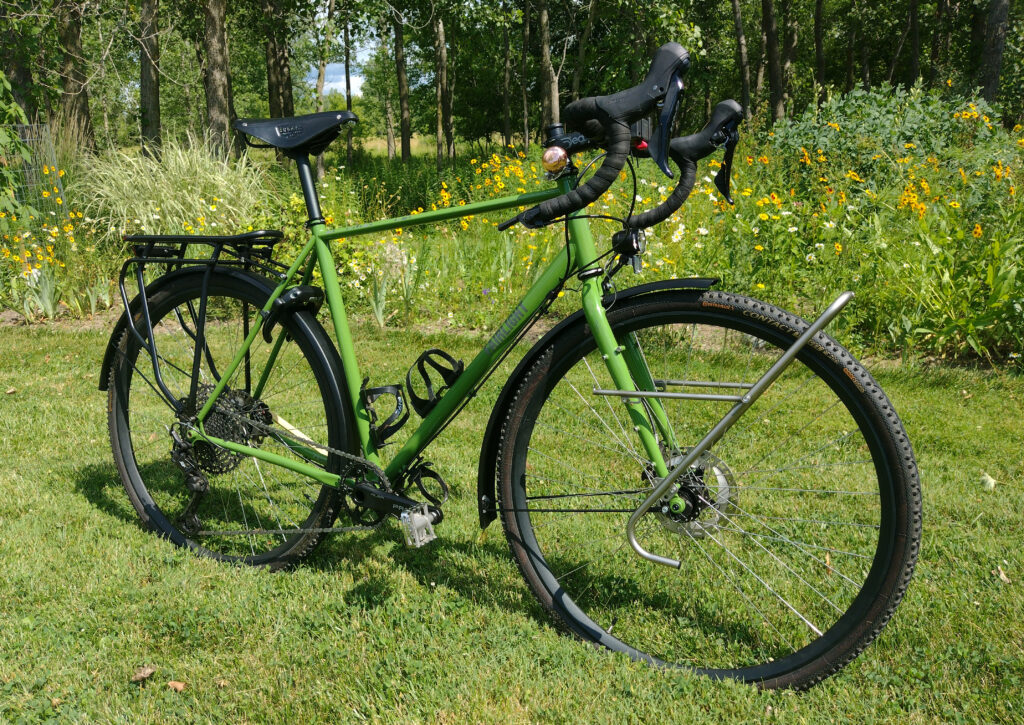
Since I built this bike as a touring bike, the ability to fit front and rear racks was one of my primary considerations when selecting a frameset. The front rack is a Tubus Tara lowrider in stainless steel with an 18kg carrying capacity which should outlast the bike itself, but cost considerations prevented me from getting the matching rear Tubus Logo rack, so I opted for a Racktime GleamIt 2.0 touring rack instead. Racktime is a spinoff of Tubus which specializes in aluminum racks, and the GleamIt 2.0 has a 25kg carrying capacity as well as in integrated rear dynamo light. I probably won’t use it, but the GleamIt 2.0 is also compatible with the SnapIt 2.0 system, which is a proprietary quick release connection allowing certain bags to be easily attached to the top of the rack.
Electronics
I opted to lace up the front wheel with a Shimano dynamo hub and my original intention was to fit a USB charging system such as the forumslader, but they are quite expensive and I have decided to put that plan on the backburner for now. However, since I have the dynohub I decided to fit the bike with a Busch & Müller IQ-XS T Senso Plus front light. The IQ-XS T Senso Plus is capable of 80 lux of light output and also has a built-in capacitor which keeps it illuminated for several minutes after the bike has stopped, as well as a sensor which automatically switches it on in low light. The light also conforms with the German StVO traffic regulations making it suitable for street use in Europe.
The rear light is also a dynamo light which is made by Trelock and came integrated into the Racktime GleamIt 2.0 rear rack.
Accessories
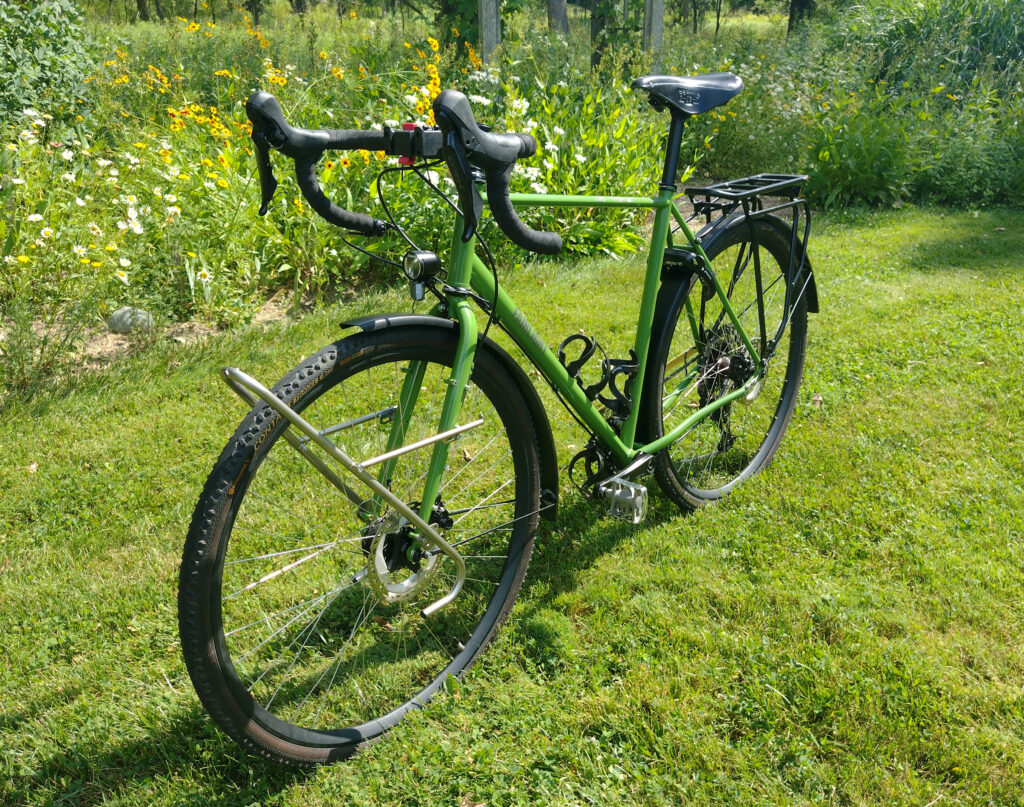
I finished this bike off with a few accessories to personalize this bike and really make it feel like my own. I added a copper plated Crane Mini Suzu stem mount bell which has the prettiest tone of any bicycle bell I’ve ever heard, and I replaced the top cap with a Merida top cap mount for my Wahoo Elemnt bicycle computer. I also added a handlebar mount for my Vaude Aqua Box handlebar bag.
The bottle cages are basic Zefal plastic spring cages, but I shifted the cage underneath the downtube further down by stacking two Topeak Alt-Position water bottle cage mounts. I zip-tied both sides of this cage together and wrapped the zip-tie in electrical tape to keep the bottle from falling out – a trick I picked up from mountain biking – and this works really well.
The mudguards are SKS Edge AL 56s which look great and have a very good mounting system, but I have found that water tends to splash out from the sides in heavy rain or when riding through puddles so I did sacrifice a little functionality for form on this one. However, I am only planning on riding in wet conditions if I get caught in the rain and the mounting system of these fenders really is a lot better than that of some of the other SKS models such as the classic Chromoplastic.
Finally, I added an Abus 5650L ring lock which sits at the top of the seat stays and allows me to lock the rear wheel in place. This adds a little weight but is a super convenient way of locking the bike up quickly for short stops in low-crime areas.
Conclusion
I have not ridden this bike very much yet as of the time of writing (May 2022), so I will do some in-depth reviews after I gain more experience, but so far I like this bike very much. The geometry seems spot on and the fit and finish of the frame is excellent. I am very happy with my choice of components, which is what makes this bike unique and also comes as close as possible to solving the current gear range limitations of 1x road bike drivetrains. I also think that I pushed the braking envelope as much as I could given the disc size limitations of the flat mount mounting standard. The only niggling doubt in my mind is the durability of the 12 speed drivetrain given the narrow chain and the use of an aluminum chainring, especially under touring conditions, but only time will tell.
The frame is also very well thought out, my one criticism would be that you are limited to running exposed externally routed cables with no option to run full-length cable housing. While I was building the bike I felt like this really limited what I could do with the bike, but I have since come around to the idea that stopped cables offer crisper shifting, and I suppose that the lack of bosses for external routing also saves a small amount of weight.
Overall this is a great bike and I am very happy with both Fairlight’s design of the frame as well as my own design choices, and I wouldn’t hesitate to recommend a Fairlight Faran in any configuration.